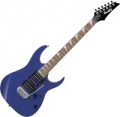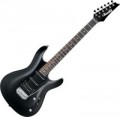Pickups
Type of pickups used in electric guitar.
—
Passive. Passive pickups are called pickups that do not use their own power supply. Such devices produce a weak signal, so guitars with passive pickups require an external preamp. In terms of sound, many musicians consider passive pickups to be more "natural" and dynamic, but this point is largely subjective. The unequivocal advantage of this option is the extensive features for experimenting with the technique of sound extraction. In addition, passive modules are much simpler and cheaper than active modules, and they do not require their own power supplies. On the other hand, these pickups are subject to feedback, which can be problematic in some situations. Yes, and sensitivity to pickups (and, accordingly, the likelihood of interference) they are significantly higher.
—
Active. Pickups supplemented with built-in preamps to increase the level of the signal fed to the output of the instrument. Thanks to the additional amplification, many models have fewer coil turns than passive models, which reduces interference and provides a cleaner and more balanced signal. At the same time, the active module retains the upper frequencies better; this gives the effect of "brightness", "transparency" of the sound. However there is an opinion that this sound turns out to be unnatural, but this moment, again, is largely subjective. But from the unequivocal disad
...vantages of active pickups, one can note the need for their own power source. One of the most popular options for this is a 9V battery, which is installed in a special compartment in the body of the guitar.Pickup diagram
Electric guitar pickup layout diagram. The letters used in this diagram indicate the types of pickups:
-
S - single. A single-coil pickup that looks like a narrow strip, often with a number of “buttons” (magnets) corresponding to the number of strings. Such modules provide clear and ringing sound, well suited for jazz, blues and other similar genres. On the other hand, the sound saturation from single-coils is not very high; they are poorly compatible with distortion and other similar effects, which is why they are poorly suited for “heavy” styles of music. In addition, such pickups are susceptible to external magnetic fields, which can degrade the sound.
-
H - humbucker. A type of pickup with two coils, originally created to compensate for the shortcomings of single coils - in particular, to reduce the level of interference from external magnetic interference. However, in the end it turned out that humbuckers differ noticeably in the color of the sound: it turns out to be less expressive, but more dense and rich, making it excellent for playing “overload” (distortion, overdrive, etc.). A classic pickup of this type has two coils positioned side by side, making it noticeably wider than a single coil; and Standard class humbuckers generally look like two single coils installed close to each other. However, in addition to this, there are other design options - for example, a hamcanseller
..., which has coils “on two levels” and is comparable in width to a single. Also note that there are humbuckers that can switch to single-coil mode (see “Coil Cutoff” for more details).
—J. A subtype of S-type pickups with one coil and an additional pole for each string. This variety first appeared on the legendary Fender Jazz Bass. J pickups have a versatile sound that suits almost any style of music.
—P. P pickups have two magnetized poles per string, but they have a unique feature: they are cut in half and wound in reverse. The advantage of this winding is the humbucker effect (see type “H”). The wide and long shape of the P pickup provides powerful and punchy sound in genres such as rock, metal, punk, etc.
- P90. A special type of single-spool single with a wider but shorter bobbin. These pickups are installed in the bridge or neck area of the guitar. Their distinctive feature is a characteristic “rock and roll” sound with warm, soft and rich timbres. Instruments with P90 pickups are often used in alternative rock, blues, indie, etc. styles.
The pickup diagram describes their types, number and relative positions. Our catalog uses a bridge-to-neck designation: for example, an HSS design means the guitar has one humbucker at the bridge and two single-coils near the neck.
This parameter determines, first of all, the overall color of the instrument’s sound. Thus, the above version of HSS will produce a sound that is quite clean and expressive, but at the same time a little denser and lower than on a purely “single-coil” electric guitar. There are many models available that are equipped with only one type of pickups. Moreover, the more pickups, the deeper and richer the sound, as a rule. In addition to all this, many other factors affect the sound of the instrument, so when choosing, you should not look only at the pickup circuit.Pickguard
The presence of a protective lining (pickguard) on the body of the guitar.
Such an overlay is located on the upper deck, most often made of durable plastic and differs markedly in colour, due to which it is clearly visible. Its main purpose is to protect the soundboard surface from pick strikes (for example, when playing with dynamic fighting), which could damage the varnished wooden surface. The specific shape and size of the fingerboard may vary, but anyway, it covers at least the surface below the strings (when looking at the guitar in the working position), and sometimes under the strings and even above them.
Through string attachment
The presence in the electric guitar of a system of through fastening of strings.
In the classic through fastening, the body of the instrument itself plays the role of a stop bar — holes are made in it, in which the strings are fixed (from the side of the bridge). The advantage of this design is the improved contact of the strings with the body, which allows you to achieve good sustain. However, in tremolo machines (see "Bridge") there is another kind of through fasteners — when the holes are located not on the body, but on the bridge; in particular, this option is typical for Vintage Tremolo machines. In such cases, the through fastening itself is only a design feature of the bridge, and the contact of the strings with the body depends on the features of the fastening of the "machine" on the body and can be different.
Number of frets
The fret is the gap between the nut on the fretboard; each such interval is responsible for its own note (the interval between the frets is half a tone). Accordingly, the more frets, the more notes you can play on one string. However, keep in mind that the width of the gaps between the nut decreases as you get closer to the bridge, and if there are a lot of frets, playing at high frets can be difficult, requiring very high accuracy.
The most popular options today are
22 or
24 frets, they are found in most electric guitars of all types. In basses, there are also a smaller number (
20 frets and
21 frets), because. the distance between the nut on such instruments is greater, and the necks, respectively, with the same number of frets, are longer than those of guitars.
In general, paying attention to this parameter makes sense, first of all, for professional musicians, for whom a vast “space for manoeuvre” is fundamentally important.
A separate category is
fretless instruments, completely devoid of nut. Almost all of them relate to bass guitars; there are also electric guitars without frets, but very rarely. In such instruments, the role of the nut is played by the musician's finger, which presses the string to the fretboard. The technique of playing fretless guitars is noticeably mor
...e complicated: firstly, to extract clean notes, you need a very precise position of the finger; secondly, this design reduces the volume of the sound and the duration of the sustain, and special playing techniques may be required to obtain the sound of the desired volume (and heavier strings for basses). On the other hand, the lack of frets gives the professional musician a number of additional options. For example, on a fretless neck, you can make very smooth slides, without stepping between notes, and the instrument itself is not tied to a standard 12-step scale, which can be very useful in some areas of music (experimental, oriental, etc.). Also note that the fretless bass guitar, both in sound and playing technique, is very close to the classical double bass, which is especially appreciated by lovers of jazz and other similar styles.Neck profile
Profile of a fretboard mounted on an electric guitar.
The profile of the neck is called its shape in section, more precisely, the shape of the back of the neck. This parameter practically does not affect the sound of the guitar, but it directly affects the convenience of playing. Ideally, the neck should “fill” the hand, but not be too large — otherwise it will not be possible to clasp it to the right extent.
Profiles are denoted by the letters C, D, V and U — depending on which letter the neck resembles in the section. Profile D is the flattest, C is slightly more convex, with almost uniform curvature along the entire length, U is more voluminous, with a wider profile in the area of the lining, and the V profile in its classic form has the form of an angle with a rounded top. There are also modifications of these options — for example, "thin", which provides for a reduced profile thickness, or "modern", with slightly improved (theoretically) ergonomics.
The most popular profile types are
C,
U and their "modern" (modern) modifications. The C profile is almost semi-circular, the U profile is more voluminous, at the fingerboard its edges are almost parallel and only closer to the back of the neck are sharply rounded. The terms
modern C and
modern U refer to various improved versions of these profiles, their f
...orm may be different.
In fact, the choice of neck profile depends solely on the guitarist's personal preferences, the characteristics of his hands and his preferred playing technique. Thus, there is no "perfect" profile shape — in each case, the optimal choice will be different. The perfect option is to try several types of profile "live", decide which one will be more convenient, and choose an instrument with a neck of the same or similar profile shape.
